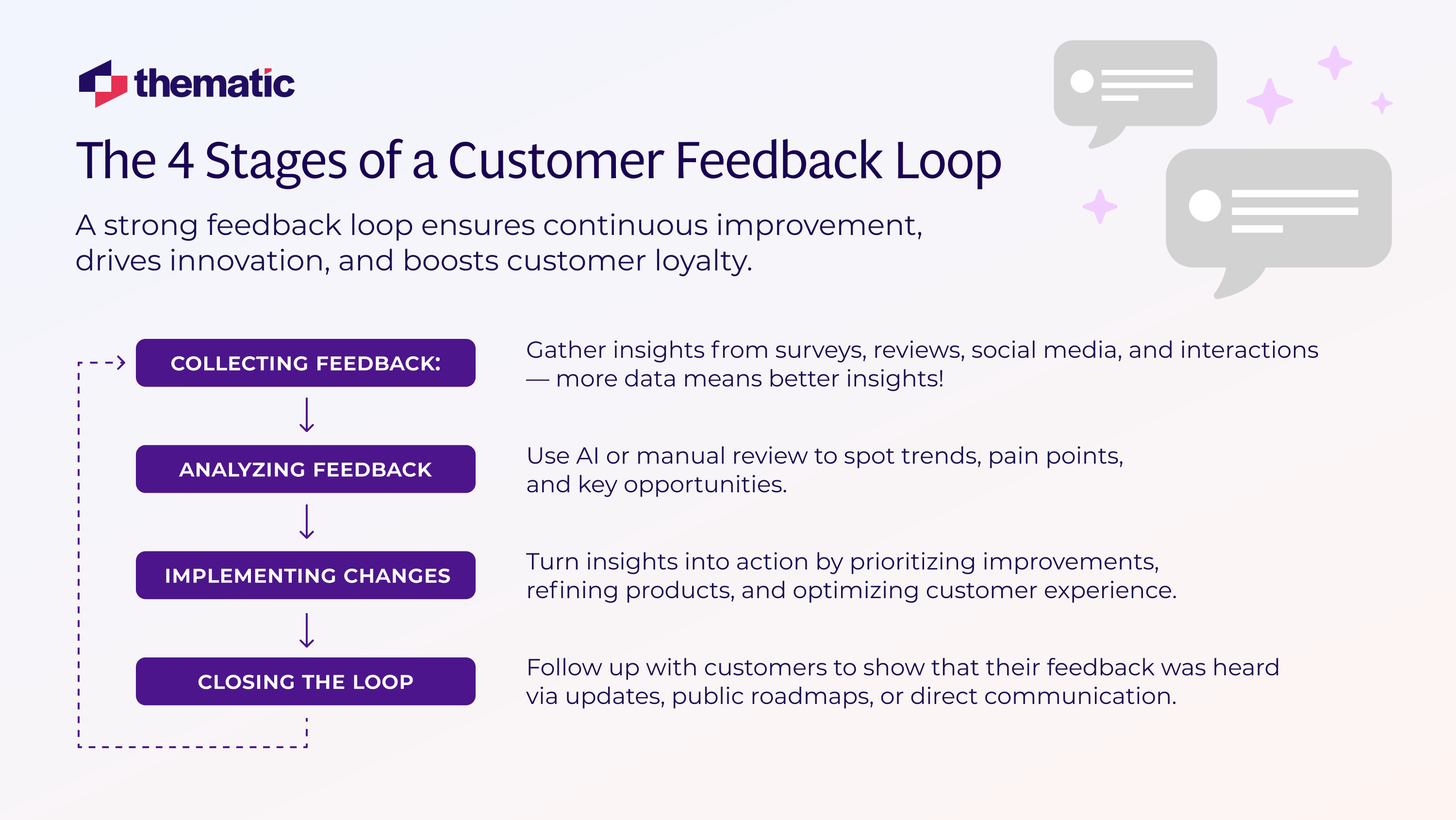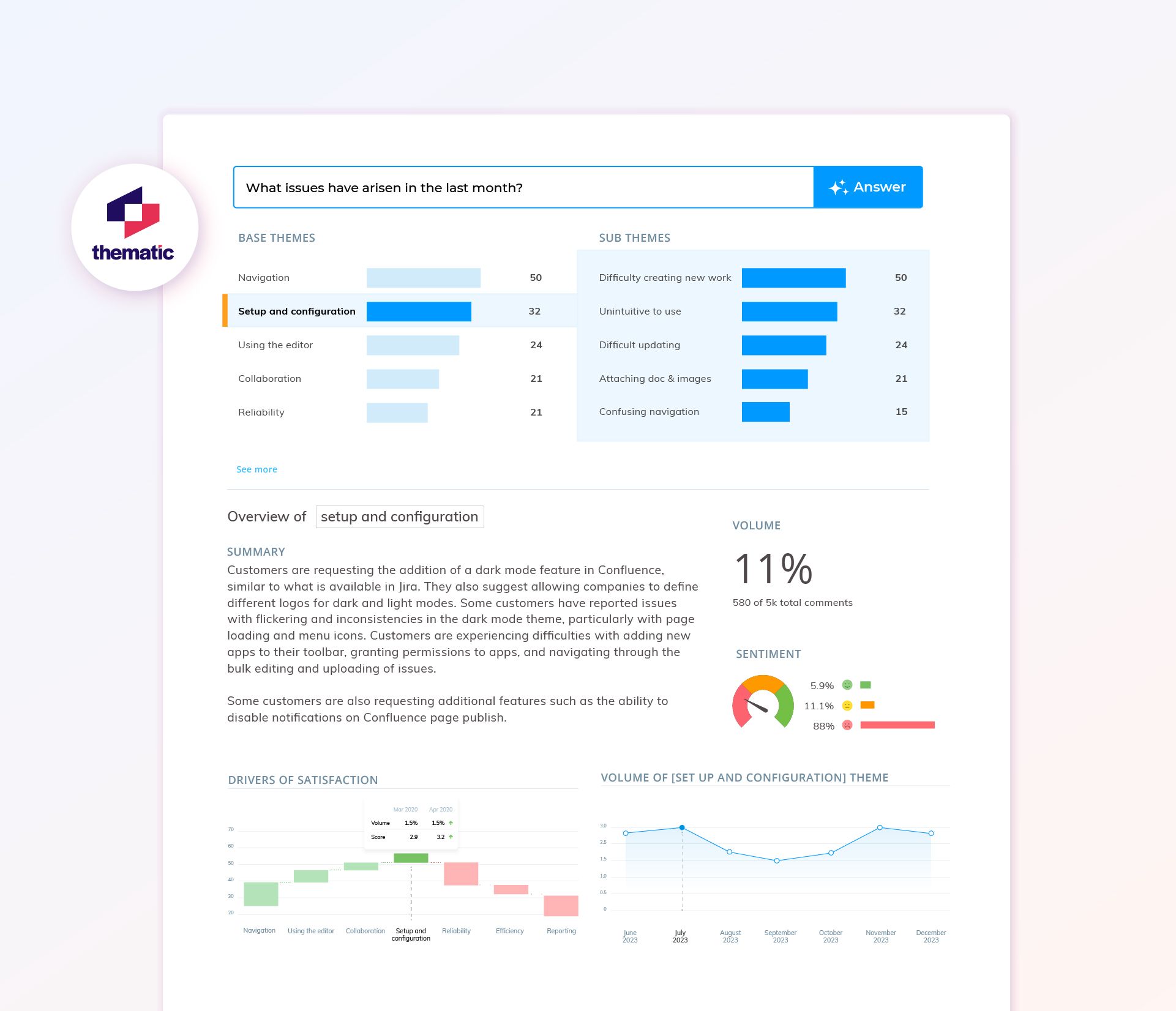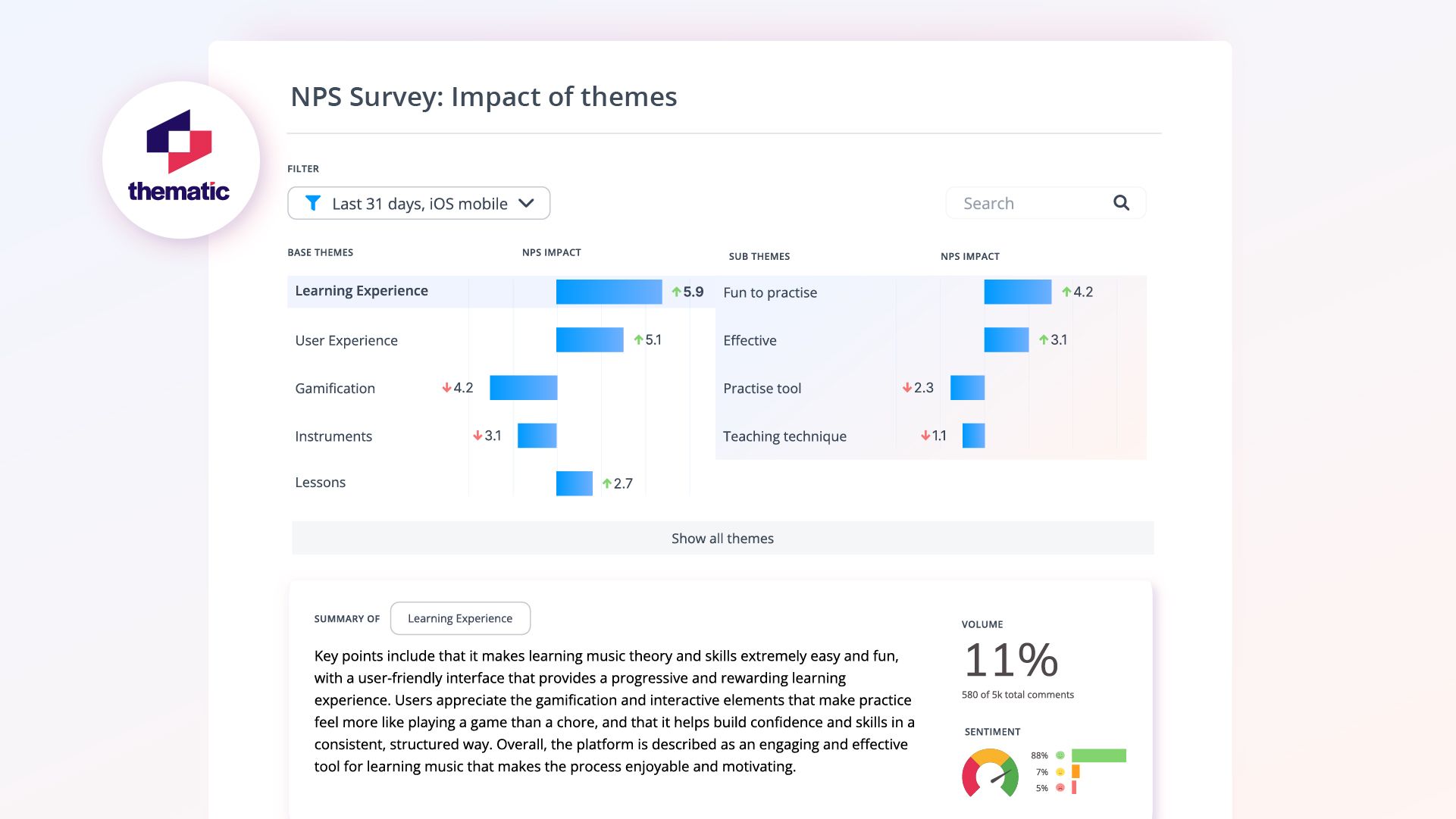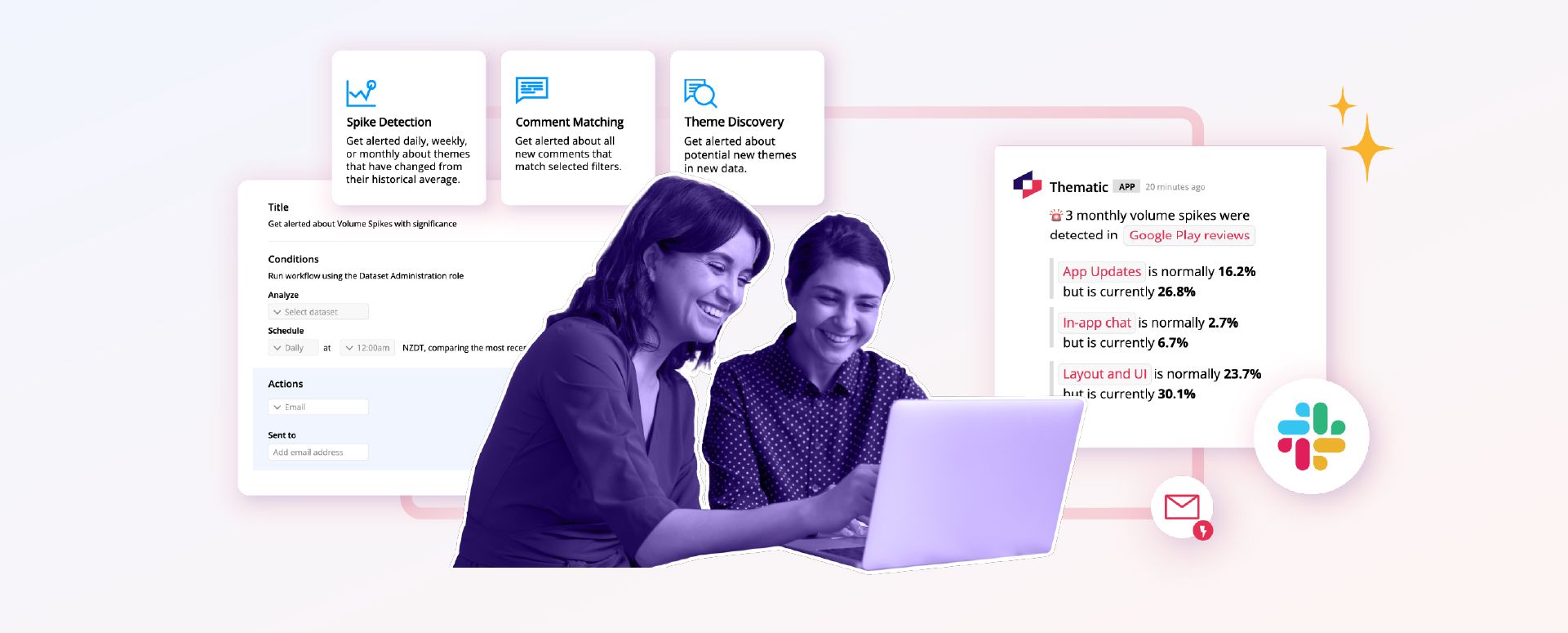
Discover how Thematic's platform streamlines the customer feedback loop, transforming insights into actionable improvements.

Ever wonder how to actually use all that customer feedback you collect? That’s where a strong customer feedback loop process comes in.
In a nutshell, a customer feedback loop is a continuous cycle of gathering feedback, analyzing it for patterns, implementing improvements, and following up with customers to let them know they’ve been heard. This process ensures you don’t just collect feedback—you act on it to drive meaningful change.
Why does this matter? For starters, keeping existing customers happy is far more cost-effective than finding new ones (it can be 5 to 25 times more expensive to acquire a new customer than to retain one). If you ignore feedback, customers may quietly slip away—56% of dissatisfied customers never voice their concerns; they just leave.
In fact, 73% of customers will switch brands after multiple bad experiences. That’s silent churn happening under the radar. On the flip side, companies that actively listen and close the loop grow 41% faster than competitors. The bottom line: a well-run customer feedback loop drives higher satisfaction, loyalty, and growth.
What exactly does the loop involve? It typically includes four stages: collecting feedback, analyzing feedback, implementing changes, and closing the loop (following up with customers).
Done right, this loop becomes a powerful engine for continuous improvement. Done wrong (or not at all), feedback ends up in a “black hole” — collected but never acted upon, leaving customers feeling ignored and businesses operating on guesswork instead of insights.
Of course, Thematic, a feedback analytics platform, can help you implement and close the customer feedback loop by turning feedback into clear, actionable insights. Using advanced AI, Thematic quickly identifies patterns and sentiments, helping you improve every step of the loop — from smarter data collection to automated analysis, prioritization, and action.
Let’s dive in!

Implementing a customer feedback loop sounds great, but many teams struggle with it in practice.
Here are some common challenges with a traditional approach to feedback management:
Modern businesses receive feedback from everywhere—surveys, support tickets, app reviews, social media, you name it. Sifting through thousands of comments and responses can overwhelm teams. Manually reading every piece of feedback is impractical, so important insights often get missed. It’s like trying to find needles in a haystack when the haystack just keeps growing.
Without the right tools, making sense of open-ended feedback is time-consuming and subjective. Teams rely on spreadsheets and pivot tables or basic text searches, which can take weeks and can introduce human bias. By the time you identify a trend (“Customers are frustrated with slow delivery updates,” for example), the issue may have already impacted many customers or evolved into something else.
Traditional text analysis methods (or doing nothing at all) just can’t keep up with the speed of customer expectations.
Often, feedback is collected but not shared widely. Perhaps the support team hears complaints about a bug while the product team separately runs a user survey about a new feature—and these insights never connect.
Working in silos means you don’t see the full picture of customer sentiment. Worse, some companies only pay attention to the loudest feedback (like a few extreme complaints) and ignore other valuable input. This selective hearing leads to a skewed understanding of customer needs.
Suppose you’ve gathered a bunch of feedback—how do you decide which issues or suggestions to address first? Traditional feedback management might rely on gut feeling or whoever shouts the loudest. There’s little data-driven prioritization. Teams can end up fixing minor issues that don’t move the needle, while neglecting things that quietly drive customers away. Without a way to quantify impact (e.g. which recurring complaints affect NPS or revenue the most), you risk spending time on the wrong improvements.
Perhaps the biggest challenge is closing the customer feedback loop. This means not only making changes, but also circling back to customers to let them know you listened.
Many companies drop the ball here—they collect feedback and maybe even act on it, but never inform customers of the improvements. Customers are left feeling like they’re shouting into a void when companies give no response.
Over time, this discourages people from giving feedback at all (“Why bother? They never respond.”). Low response rates and disengaged customers are the result of a broken loop.
These challenges can make a customer feedback loop process stall out or feel impossible to manage.
The good news? New technology, especially AI, is changing everything. Instead of drowning in data or responding too slowly, teams are using AI-driven customer insights platforms to transform the feedback loop into an efficient, closed circuit.
Next, we’ll look at how Thematic addresses these pain points at every step.
Traditional methods have their limits, but AI feedback analytics solutions like Thematic are here to reinvent how we handle customer feedback. Thematic’s platform was built specifically to make feedback loops faster, smarter, and more effective.
Let’s break down how it enhances each stage of the feedback loop process:
One big hurdle in the feedback loop is simply gathering all your customer input in one place. Feedback comes in many forms—survey responses, NPS comments, support emails, live chat transcripts, app store reviews, social media posts, and more.
Thematic simplifies feedback collection by offering seamless integrations with the tools you already use. Whether your data lives in SurveyMonkey, Zendesk, Intercom, Salesforce, or a CSV export, Thematic lets you pipe it in with one click into a unified platform.
This means no more copy-pasting or juggling multiple spreadsheets.
All your qualitative feedback and quantitative metrics (like ratings or NPS scores) can be combined and analyzed together. By breaking down data silos, Thematic ensures you’re listening to customers across their entire journey. You can even import historical feedback to analyze trends over time.
The result is a complete view of customer sentiment from all.

Once feedback is collected, the next challenge is making sense of it. This is where Thematic’s feedback analytics AI engine shines. The platform uses advanced Natural Language Processing (NLP), particularly large language models, and machine learning to automatically analyze text feedback and group it into meaningful themes and topics.
In other words, Thematic does the qualitative data analysis—reading all those open-ended responses—for you.
Thematic codes qualitative data and analyzes it at a speed and scale no human team could match.
Thematic’s proprietary AI doesn’t rely on a preset dictionary of categories; it actually learns from your data, finding recurring ideas and phrases that represent customer concerns or praises.
For example, it might detect themes like “delivery time” or “UI ease of use” emerging from comments, even if you didn’t pre-define those tags. This self-supervised approach means you catch the unknown unknowns—insights you weren’t explicitly looking for—without any manual coding of responses.
Alongside theme detection, Thematic analyzes sentiment, so you know if each theme is mentioned positively, negatively, or neutrally.
It’s not just counting keywords; it truly understands context and tone. (For instance, it knows the difference between “The app is fast and easy” vs “The support team was fast to dismiss my issue”.) This helps pinpoint not just what customers talk about but how they feel about those topics.
Thematic’s feedback analytics AI works quickly—processing feedback in near real-time once data is connected. Instead of waiting weeks for a manual report, you can get instant insights as new feedback comes in.
This agility lets you respond to emerging issues or trends before they escalate. Atlassian's Mick Stapleton describes Thematic as “your own personal analyst that works 1000 times faster and never takes a day off”!
Perhaps the best part is that Thematic’s feedback analysis is transparent and customizable. You’re not stuck with a mysterious “black box” output. The platform provides a Theme Editor that lets you review and refine the AI-generated themes.
If you see a theme that’s too broad or mislabeled for your context, you can easily tweak it—and the AI will adjust the analysis across the entire dataset. This combination of AI speed and human oversight means you get highly accurate, trustworthy insights that reflect your business’s unique vocabulary.
Users at Atlassian praised this flexibility, noting that Thematic’s feedback analytics AI improved over time and even outperformed human analysis, all while they could guide it as needed.

Identifying themes and sentiments is a huge step forward, but the real magic happens when you link those insights to business impact. Thematic helps you answer the crucial question: “What should we tackle first?”
The platform includes powerful analytics and visualization tools to quantify the importance of each theme.
For example, you can see charts of theme frequency (how often a topic comes up) and the average sentiment or rating associated with that theme. Even more impressively, Thematic has an “Impact” analysis widget that shows how each theme correlates with key metrics like NPS, CSAT, or customer churn. In one glance, you can tell which issues are dragging your scores down the most (or which positive themes are lifting them up).
This data-driven approach to prioritization means you can confidently focus on changes that will have the biggest effect on customer satisfaction and loyalty. Instead of guessing, you have evidence.
Thematic also enables you to slice and dice the data by segments or filters—for example, viewing themes by region, customer tier, or product version. This helps in identifying patterns like “Customers on the premium plan complain about onboarding more than basic-plan customers”—valuable for targeted improvements.
And when you have a new idea, Thematic’s Generative AI capabilities come into play: with Thematic Answers, you can literally ask questions about your feedback data in plain English and get instant answers.
Type something like “What are the top pain points for our mobile app users last quarter?” and Thematic will generate a summary based on the analysis. This makes it super easy for any team member (even non-analysts) to dig into insights on the fly, accelerating the feedback loop further.
As one user put it,
“I love the simplicity of Answers… it makes it really easy to find what people are saying about specific things”.
In short, Thematic not only organizes your feedback but also highlights what matters most so you can prioritize with confidence.

Insight is only powerful if you act on it. The final stage of the feedback loop is turning analysis into tangible improvements—and letting customers know about them.
Thematic makes this step easier by bridging the gap from data to action:
Thematic provides intuitive dashboards and reports that can be easily shared with stakeholders across your organization.
Rather than overwhelming executives with raw data, you can present a clear narrative: “Here are the top 3 issues hurting our NPS, here’s verbatim customer quotes illustrating each, and here’s our plan to address them.”
Thematic even helps you pull those customer quotes directly (thanks to the Feedback tool) so you can include real examples to make a point. These storytelling capabilities help get buy-in for product or policy changes by vividly illustrating customer pain points.
Need to make sure the right teams act on the insights? Thematic has you covered with workflow integrations. You can set up alerts or automations—for instance, trigger a Slack message to the UX team when a new theme about “checkout bug” spikes, or export a list of feedback comments about “billing issues” to a Zendesk ticket for the finance team.
By hooking into your existing tools, Thematic ensures critical feedback doesn’t stay in the analytics platform—it reaches the people who can solve the problem. This keeps the loop moving forward quickly, turning insight into execution.

After implementing a change, you can use Thematic to monitor new feedback and see if the needle moves.
Continuous feedback analysis lets you validate that your actions had the desired effect, completing the cycle of the customer feedback loop process.
It essentially creates a closed-loop system of improvement:
feedback → insight → action → more feedback to confirm the improvement or identify new issues
In other words, Thematic helps you build an infinite feedback loop that keeps evolving with your business.
Finally, Thematic indirectly makes it easier to close the loop with the customers themselves. How? By quickly pinpointing issues and their root causes, your team can formulate a response or solution faster and communicate with the affected customers.
Some Thematic users set up automated responses for certain feedback categories; others use the insights to publish “You said, we did” updates in their communities.
When customers see a company closing the customer feedback loop (i.e., acting on feedback and responding back), it builds trust and encourages even more feedback. It’s a virtuous cycle.
In short, Thematic doesn’t stop at analysis; it helps you operationalize feedback insights. From sharing dashboards to setting up workflows, it ensures the right actions are taken, and the loop is truly closed. You’ll be able to move from insight to improvement in days instead of months, keeping customers in the loop (literally!) and demonstrating that their feedback leads to real change.

Atlassian, the company behind popular tools like Jira and Trello, faced a challenge familiar to many growing businesses: managing an overwhelming amount of customer feedback. With around 60,000 pieces of feedback pouring in each month, they needed a way to not just collect this information but to turn it into meaningful action.
By partnering with Thematic, they established a robust customer feedback loop that transformed their approach. Let's walk through how they tackled each stage:
Atlassian's users shared their thoughts through various channels—public forums, support tickets, and surveys. While this provided a wealth of insights, it also led to a fragmented system where valuable feedback could easily slip through the cracks. Recognizing the need for a more organized approach, Atlassian aimed to create a seamless experience for customers to share their input across multiple platforms.
With mountains of data collected, the next challenge was making sense of it all. Manually sifting through feedback was time-consuming and prone to bias. Enter Thematic: using advanced NLP and machine learning, Thematic automatically identified themes and sentiments within the feedback. This allowed Atlassian to quickly pinpoint recurring issues and understand the underlying emotions, streamlining what was once a daunting task.
Armed with clear insights, Atlassian's product teams could now prioritize and address the most pressing user concerns. Thematic's transparent and flexible system enabled teams to validate their analyses and focus on making impactful improvements.
For instance, they discovered that users desired a more intuitive way to query issues using natural language instead of the complex JQL syntax. By addressing such specific feedback, Atlassian enhanced user satisfaction and product usability.
Understanding that feedback is a two-way street, Atlassian emphasized the importance of letting customers know their voices were heard. They developed a public-facing policy to manage customer expectations, outlining how feedback would be processed and how users would be informed about developments.
By communicating back to customers about how their input influenced product changes, Atlassian fostered trust and encouraged ongoing engagement.
Going through all four stages of the customer feedback loop with the help of Thematic, Atlassian successfully transformed overwhelming feedback into actionable insights, leading to improved products and a more engaged user community.
As Bill Gates said, "Your most unhappy customers are your greatest source of learning." But may we add that not only your unhappy customers but also the happy ones—all of them can bring you great insights. And as you learn from them, polish your process to boost and maintain customer satisfaction.
Creating a robust customer feedback loop is no longer a “nice to have”—it’s a must-have. Remember: the companies that win are those that listen to their customers and continually adapt based on feedback.
But doing this at scale requires the right process and tools.
Traditional feedback management methods often buckle under the pressure of big data and fast-changing customer expectations. As we discussed, they can lead to slow responses, missed insights, and frustrated customers who feel ignored.
Fortunately, feedback analytics platforms like Thematic offer a way to break through those barriers. By automating collection and analysis, highlighting what matters most, and enabling quick action, Thematic helps you build an infinite feedback loop that keeps customers at the heart of every decision.
Whether you’re aiming to reduce churn, boost customer satisfaction, or discover the next big product innovation, a solution like Thematic can be your catalyst. Ready to close the loop and unlock the insights hiding in your customer feedback? Experience feedback analysis in action on your own data with a demo of Thematic.
Join the newsletter to receive the latest updates in your inbox.